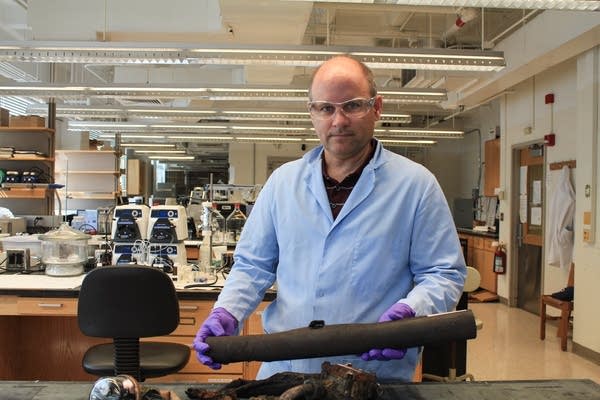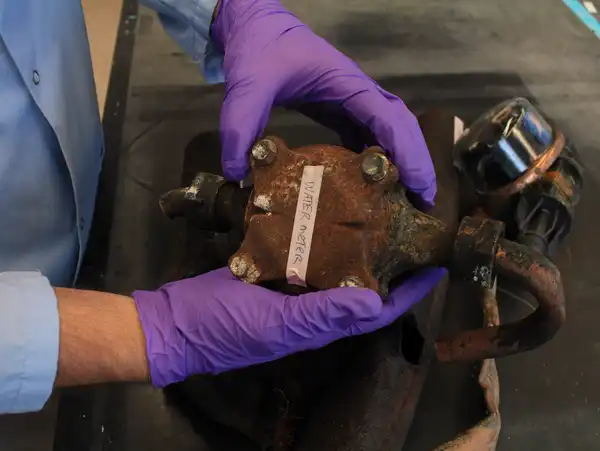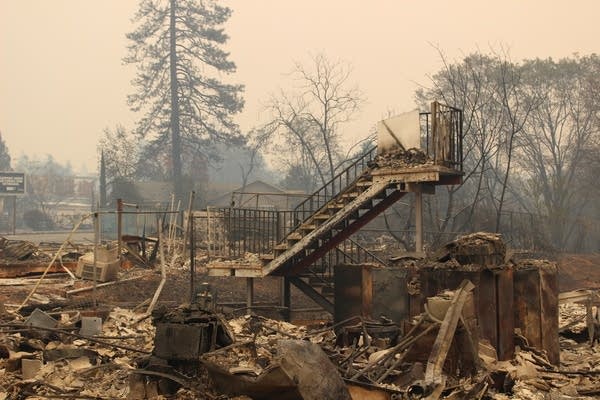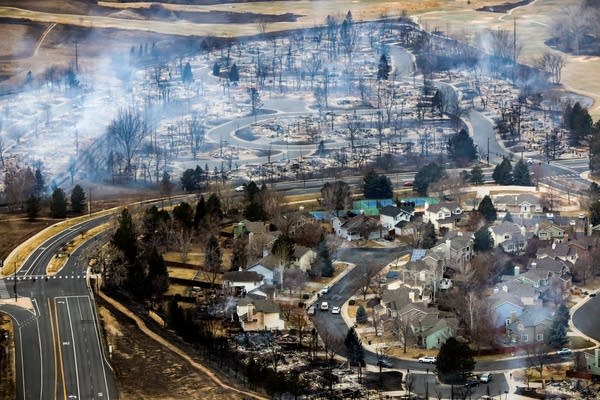When wildfires compromise drinking water, utilities lean on this professor’s advice
In 2017, the Tubbs Fire in Santa Rosa, California, exposed a new threat to public health: Wildfires can contaminate drinking water with toxic chemicals which federally mandated testing is not designed to catch. Into that regulatory void has stepped Andrew Whelton, an engineering professor at Purdue University who has made it his personal mission to help water utilities recover after devastating fires.

In 2017, after the Tubbs Fire blazed through parts of California’s wine country, a Santa Rosa resident returned home to one of the few structures left standing in his fire-scarred neighborhood. He turned on the tap and reported that the water smelled like gasoline.
Sampling identified the source of the odor as benzene, a compound found in petroleum products. One sample contained 8,000 times the amount of benzene the Environmental Protection Agency allows in drinking water. After ruling out the usual culprits for benzene contamination, such as a gasoline spill or leaking underground storage tanks, utility staff were left with a startling realization: The wildfire had contaminated the water system.
Typically, state regulators support and guide how public water systems address contamination. But this threat from wildfire was new. No guidance or protocol existed for Santa Rosa’s water system to follow. Staff at Santa Rosa Water started reaching out to experts with experience responding to chemical spills, including a Purdue University engineering professor named Andrew Whelton. Whelton replied with exceptional interest, said Emma Walton, then a deputy director at the utility.
Since then, at least 8 wildfires have contaminated public drinking water systems across the United States, and Whelton has become the de facto national authority on response and recovery.
He has rushed from his home in Indiana to the side of utility managers from Colorado to Hawaii who were facing some of the most stressful infrastructure crises of their careers. He has clashed with California regulators over specific protocol and recommended managers test for more contaminants than regulators there require. Last year, Whelton published a blueprint for how water utility staff can look for and decontaminate their systems. Utility managers say it provides a resource in an area where federal and state guidelines are lacking.
“It’s hard to describe how complex it was before we had this resource, because you were doing a lot of guessing on what was right and wrong,” said Kurt Kowar, a utility director who sought Whelton’s help in the aftermath of Colorado’s Marshall Fire in 2021. “And now there’s no more guessing.”

Jonathan Leung, director of water quality at Los Angeles Department of Water and Power, said his staff referred to this playbook to make their recovery plan after the LA fires earlier this year.
Armed with this tool, LADWP was able to restore water service in two months.
‘He wrote back, I think within 30 minutes’
The benzene found in Santa Rosa’s water is one of many VOCs, or volatile organic compounds, that can enter municipal water systems when the buildings they’re connected to are destroyed by wildfire.
VOCs are a broad category of chemicals known for their ability to off-gas. They’re found in household and industrial products, including paints, pesticides, dry cleaning agents and petroleum fuels. They also form during natural processes such as volcanic eruptions and forest fires.
Before the Tubbs Fires, experts understood that wildfires can contaminate water sources through soil erosion and runoff. Events in Santa Rosa revealed that wildfires can also contaminate water systems at the pipes that bring treated drinking water to buildings.
Experts say it works like this: damage to structures and excess demand for water cause depressurization. This creates a vacuum in the distribution system that can pull contaminants into service lines, water mains and connecting fixtures. Plastic pipes can also degrade at high temperatures, causing chemicals in the plastic to leach into the water. The contamination can be distributed unevenly in damaged areas, making it difficult to catch without sufficient sampling.
The Environmental Protection Agency regulates about 20 VOCs in drinking water that harm human health. Benzene, for example, has been linked to anemia, a decrease in blood platelets and an increased risk of cancer. The agency limits benzene in drinking water to 5 micrograms per liter.
California has a lower allowable maximum at 1 microgram per liter. If a million people consumed contaminated drinking water at this concentration over a 70-year period, the chemical would cause between six and seven cases of cancer, according to California regulators.
But national drinking water standards set by the EPA do not account for this newly understood mode of contamination from wildfires. Water utilities routinely monitor for VOCs as the water leaves the treatment plant, upstream of where wildfire contamination is likely to occur.
In 2018, after the Camp Fire engulfed more than 90% of Paradise, California, Kevin Phillips needed answers to some pressing questions. The Paradise Irrigation District had just confirmed the presence of benzene in its water system and Phillips, the district manager, wanted to know if it would permanently contaminate the pipes. A contact at the University of California, Berkeley, suggested his team reach out to Whelton.
“(Whelton) wrote back, I think within 30 minutes, a list of things we should look for and how we go about this,” Phillips said.


In his response, Whelton recommended that Paradise begin by flushing the distribution network to remove any contaminated water currently in the pipes. But, he cautioned, success depended on the types of materials the water came into contact with, the concentration of chemicals in the water, the water temperature and other factors.
“Plastics would be my biggest concern,” Whelton wrote. “Once you flush away the contaminated water, chemicals absorbed inside the plastic will then begin to leach out into the clean water.”
The speed at which the chemicals leach out of the plastic determines how long decontamination takes, regardless of flushing, Whelton added.
About a month later, Phillips flew Whelton and a small team from Purdue to Paradise to assist.
“From that point on, he was really kind of our go-to expert when it came to water contamination,” Phillips said.
This would not be the last time Whelton would steer a besieged water utility through such a crisis.

About three years later, the Marshall Fire plowed through several neighborhoods in the town of Louisville, Colorado. Kurt Kowar, director of public works and utilities in Louisville, said state regulators told him their agency didn’t have the expertise to address this kind of contamination.
Instead, they suggested that he call Whelton, who Kowar then looked up on Twitter. Kowar said Whelton called within a half an hour of receiving Kowar’s introductory email.
By the end of their conversation, Kowar said he knew what he needed to do next. “That’s when I said, ‘I’m gonna buy you a plane ticket. You're gonna get on a plane. You're gonna come here tomorrow, because we got to figure this out.’”
Whelton, who had just returned home from a business trip, immediately headed to the airport, booking a redeye flight on his way there.
‘We need to train these leaders … to help themselves’
The next morning, Whelton, Louisville water system staff, state regulators and others Whelton had recommended met in a nondescript conference room to make a plan.
From his seat in the back of the room, Whelton noticed their questions were similar to the ones utility staff in Santa Rosa and Paradise had posed when they were going through their respective water contamination crises.
This time, Whelton decided to take notes.
Whelton had worked for the U.S. Army on water infrastructure security before going into academia. The experience left him a firm believer in establishing military decision-making frameworks to address emerging disasters.
He decided to turn their questions into a similarly styled manual for water utility recovery in the aftermath of a wildfire.
He started putting together a concept of operations, or CONOPS, plan for water distribution system testing and recovery. The name was a nod to his military experience.
With funding from the Water Research Foundation, a nonprofit that serves water utilities, Whelton and two other Purdue researchers published the guide in 2024 to help utility managers “get from Point A to Point B with an evidence-based approach,” Whelton said.
The report outlines the responsibilities of different parties during disaster response, from water utility staff to public health officials to state drinking water regulators. It also helps utility managers determine their options after a system tests positive for contamination.
Prior to the CONOPS, such information was spread out “on websites or in news articles or in people’s heads,” Kowar said.
The EPA issued a seven-page document in 2021, but it reads like a “high-level guidance,” Kowar said. The CONOPS plan “is a much more thorough, vetted document” that takes the guesswork out of recovery efforts and reflects industry best practices, he said.
During the 2023 wildfires in Maui, the CONOPS plan got its first test run with Whelton, Phillips and Kowar present.
“I have no interest in doing this for the next 10 to 20 years,” Whelton said. “We need to train these leaders, operators and engineers in communities to help themselves in times of crises.”

‘If somebody would have shown me a draft’
In 2024, California law began requiring water utilities to test for benzene contamination whenever a wildfire of 300 or more acres damaged or destroyed structures connected to a water system. California appears to be the only state with mandated testing after wildfires.
But according to Whelton, California’s law is not protective enough because it only requires water systems to test for benzene and not other VOCs.
The idea that a single chemical could be “the panacea for a complex issue is bonkers,” he said. “If somebody would have shown me a draft of what actually got promulgated, I would have made clear that the code as written is going to result in potentially unsafe water for people.”
While benzene is the most common VOC found in water after wildfires, data from previous fires shows that other VOCs can contaminate drinking water after wildfires, too. Sometimes those VOCs are present even when benzene isn’t.
This happened in about a quarter of the samples taken after the Marshall Fire, according to Corona Environmental Consulting, a local agency that worked on the response.
Regulators at the California State Water Resources Control Board who weighed in on the law have said benzene is an adequate indicator for VOC contamination nevertheless.
Darrin Polhemus, deputy director of the state water board’s drinking water division, acknowledged that other VOCs will sometimes show up in samples where benzene is not present. But he said that benzene has the highest signal of all the VOCs based on sampling data.
“Because of that, what we believe is that if you can manage for benzene, you’re basically managing for all of them,” Polhemus said, chalking the differences in perspective up to risk perception. “We’re dealing with the practicalities of cost and time and how to manage that compared with getting people back to their homes.”
While Whelton disagrees, he said he is glad that “California decided that it’s important that people have their drinking water tested after a wildfire.”

On the ground in Los Angeles
After the January wildfires, Leung, the director of water quality at LAWDP, said his team opted to test for a broad panel of VOCs even though state law only required them to test for benzene.
Of the 482 samples they took, Leung said, VOCs were detected without benzene present about 11 percent of the time, but “at levels far below the drinking water standard.”
Leung said his counterparts at the public water system in Oakland, California sent him Whelton’s plan in the days after the fires. It was a document Leung said he found himself returning to as he began thinking about the water system’s next steps.
Screening for and removing wildfire contaminants is “not necessarily intuitive,” he said.
In the past, water utilities have thought their water systems were clean after analyzing samples taken immediately after flushing, only to have contaminants show up later as chemicals that had adhered to plastic pipes leached back into the water.
Leung said he took care to make sure that the water sat in the pipes for 72 hours before collecting samples, even though the water system used mostly metal pipes.
He said Whelton’s plan helped him understand how different pipe materials absorb, retain and release VOCs, which cleaning strategies to use and which areas of the water system to prioritize. Since LADWP’s water system had mostly copper, steel and galvanized iron water lines, Leung realized there was less concern about chemicals adhering to pipes.
This, to Whelton, is proof that the CONOPS plan is working.
The plan empowered water utilities in Los Angeles County to address the threat of contamination head-on, Whelton said. “They actually read the plan, they used it, they called us on the telephone or webinar, and then they made decisions for themselves and were able to find their way out of that disaster.”
Whelton said he worries that some people outside of California may see VOC contamination as “a California problem,” even though wildfires are increasingly intersecting with urban communities because of climate change. And outside of California, it is completely discretionary whether a water system tests for contamination after a wildfire, Whelton said.
Effective disaster response depends on who’s in the room making decisions and the information they have access to, Whelton said.
Whelton takes heart in the fact that public servants such as Walton, Phillips and Kowar have “stepped up when they were not legally required to,” and in doing so helped create the CONOPS plan.
“I drove the effort, but it was because of everyone else coming together (that) we were able to deliver,” he said.